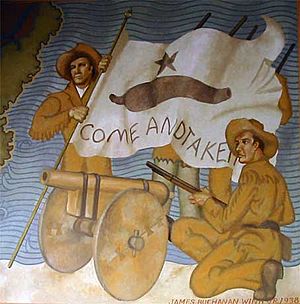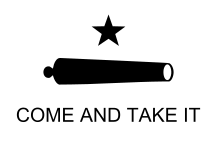Come and take it facts for kids
"Come and take it" is a famous slogan that means "Come and try to take this from me if you dare!" It shows a strong refusal to give up something important.
This phrase was first used a very long time ago, in 480 BC. During the Battle of Thermopylae, the Spartan King Leonidas I used the Greek words "Molon labe" (meaning "Come and get them!") when the Persian Army demanded his soldiers' surrender.
Later, the slogan was used in two important events in American history. It was heard in 1778 during the American Revolutionary War at Fort Morris. It was also used in 1835 at the Battle of Gonzales during the Texas Revolution.
Contents
American Revolutionary War: Fort Morris
Sunbury, Georgia, was once a busy port town, but now it is a ghost town. During the American Revolutionary War, a fort called Fort Morris was built there.
On November 25, 1778, a group of British soldiers tried to capture Fort Morris. The American soldiers defending the fort were led by Colonel John McIntosh. There were only 127 American soldiers, plus some local fighters. The fort was not very strong and could not have lasted long against a big attack.
The British commander, Colonel Fuser, sent a note demanding that the Americans surrender. Even though he was greatly outnumbered, Colonel McIntosh sent a brave reply. His message included the famous line: "As to surrendering the fort, receive this short reply: COME AND TAKE IT!"
The British decided not to attack. They thought Colonel McIntosh's bold answer might mean that more American soldiers were hiding nearby. So, the British soldiers left.
In January 1779, the British came back with a much larger force. They eventually took control of most of Georgia for a few years. Colonel McIntosh's brave stand at Fort Morris inspired many American patriots during the war.
The Fort Morris Historical Marker is located in Midway, Georgia. It is at the visitor center for the Fort Morris Historic Site. This marker tells the story of the battle and Colonel McIntosh's famous "Come and Take It!" response.
Because of his bravery at Fort Morris, the Georgia Legislature gave Colonel McIntosh a special sword. The words "Come and Take It" were carved onto its blade. Colonel McIntosh continued to serve his country. He later became an American General in the War of 1812, still protecting the Georgia coast.
Texas Revolution: The Gonzales Cannon

In 1831, the people of Gonzales, Texas, asked for a cannon to help defend their settlement. They received a small, used bronze cannon. This cannon became a symbol of pride for the Texans.
In 1835, the Texas Revolution began. Mexican forces, led by Colonel Domingo de Ugartechea, were ordered to take back the cannon from Gonzales. This led to a small fight known as the Battle of Gonzales. This was the first land battle of the Texas Revolution.
As a sign of their defiance, the Texans created a special flag. It had the words "come and take it" (in Spanish, Spanish: Ven y tómalo) on it. The flag also showed a black star and a picture of the cannon itself. This flag showed the Mexican government that the Texans would not give up their cannon. The Mexican military's attempt to take it back by force failed.
You can see replicas of this historic flag in many places today. These include the Texas State Capitol, the Bullock Texas State History Museum, and the Sam Houston State University CJ Center. You can also find them at the University of Texas at El Paso Library and Duke University.
Adapted Uses of the Slogan
The "Come and Take It" flag and slogan have been used in many new ways in recent times.
Since the 1990s, people who support the Second Amendment (the right to own guns) have used modified versions of the flag. One of the first changed versions replaced the cannon with an M16 rifle. This flag was shown at rallies to support gun rights.
Later, other versions of the flag were made. Some showed different types of firearms, like a Barrett .50 BMG Rifle. People have also created flags with other objects that are important to them. For example, during the 2000 Stanley Cup Finals, a fan of the Dallas Stars hockey team made a flag with the Stanley Cup instead of the cannon. The Stars were the champions that year.
The rock musician Ted Nugent released a song called "Come and Take It" in 2021. He is well-known for supporting gun rights. He also sells "Come and Take It" merchandise on his website.
See also
 In Spanish: Ven y tómalo para niños
In Spanish: Ven y tómalo para niños






